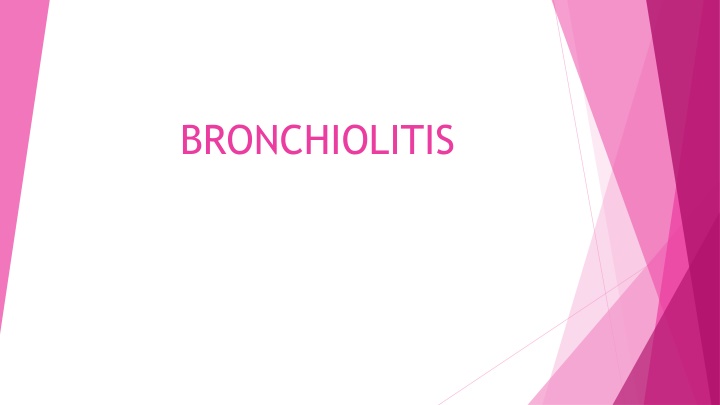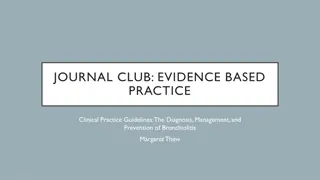BRONCHIOLITIS
Acute bronchiolitis is a viral lower respiratory tract infection that affects infants and young children, characterized by respiratory symptoms like tachypnea, wheezing, and crackles. The pathophysiology involves bronchiolar obstruction, leading to hypoxemia and potential hypercapnia. Respiratory syncytial virus (RSV) is a common cause. Males, second-hand smoke exposure, lack of breastfeeding, and crowded conditions increase risk. Early signs include upper respiratory symptoms followed by tachypnea and feeding difficulties. Prompt recognition and management are crucial in treating bronchiolitis in the pediatric population.
Download Presentation

Please find below an Image/Link to download the presentation.
The content on the website is provided AS IS for your information and personal use only. It may not be sold, licensed, or shared on other websites without obtaining consent from the author.If you encounter any issues during the download, it is possible that the publisher has removed the file from their server.
You are allowed to download the files provided on this website for personal or commercial use, subject to the condition that they are used lawfully. All files are the property of their respective owners.
The content on the website is provided AS IS for your information and personal use only. It may not be sold, licensed, or shared on other websites without obtaining consent from the author.
E N D
Presentation Transcript
DR.ALIREZA ESHGHI PEDIATRIC PULMONOLOGIST
Acute bronchiolitis is a diagnostic term used to describe the clinical picture produced by several different viral lower respiratory tract infections in infants and very young children
The respiratory findings observed in bronchiolitis include tachypnea, wheezing, crackles, and rhonchi which result from inflammation of the small airway
The pathophysiology of acute bronchiolitis is characterized by bronchiolar obstruction with edema, mucus, and cellular debris
Hypoxemia is a consequence of ventilation-perfusion mismatch. With severe obstructive disease hypercapnia can develop
Respiratory syncytial virus (RSV) is responsible for more than 50% of cases of bronchiolitis in most reports. Other agents include human metapneumovirus, rhinovirus, parainfluenza, influenza, bocavirus, and adenovirus
Bronchiolitis is more common in males, those exposed to second-hand tobacco smoke, those who have not been breastfed, and those living in crowded conditions. Risk is also higher for infants with mothers who smoked during pregnancy
History and Physical Examination The infant first develops signs of upper respiratory tract infection with sneezing and clear rhinorrhea. This may be accompanied by diminished appetite and fever
The infant is often tachypneic, which can interfere with feeding. Apnea may precede lower respiratory signs early in the disease, particularly with very young infant
The diagnosis of acute bronchiolitis is clinical, particularly in a previously healthy infant presenting with a first episode of wheezing following a period of upper respiratory symptoms
Chest radiography is not routinely indicated in children with suspected bronchiolitis. Areas of atelectasis associated with bronchiolitis are often observed on chest radiographs and may be difficult to distinguish from bacterial pneumonia
Laboratory testing is also not routinely indicated; the white blood cell and differential counts are usually normal and are not predictive of bacterial superinfection. Viral testing (polymerase chain reaction, or rapid immunofluorescence) is not routinely recommended in the diagnosis of bronchiolitis but may be helpful if such testing prevents more invasive evaluations. Concurrent serious bacterial infection (sepsis, pneumonia, meningitis) is unlikely, although confirmation of viral bronchiolitis may obviate the need for a sepsis evaluation in the young febrile infant. Otitis media may complicate bronchiolitis.
Children with recurrent or refractory episodes of wheezing in infancy, particularly if associated with failure to thrive, may require evaluation for chronic disorders such as cystic fibrosis or immunodeficiency
The treatment of children with viral bronchiolitis is supportive management. Those who are experiencing respiratory distress (hypoxia, inability to feed, apnea, extreme tachypnea) should be hospitalized. Risk factors for severe disease include younger age, preterm birth, or underlying comorbidity such as cardiovascular, pulmonary, neurologic, or immunologic disease
Hypoxemic children should receive supplemental oxygen. There is a developing consensus surrounding target oxygen saturations; national guidelines in the United States propose a threshold of 90%. Oxygen can be administered via a number of delivery devices, and some children with severe disease may require positive pressure ventilation. High-flow nasal cannula is a noninvasive mode of oxygen delivery capable of providing some positive end expiratory pressure, particularly in young children. Some use high flow as rescue therapy in patients who do not
Some children may also require support with supplemental hydration. Fluid can be administered intravenously or enterally via nasogastric tube, with some preference given to the latter due to an association between better outcomes and continued provision of enteral nutrition
Frequent suctioning of nasal and oral secretions often provides relief of distress and improves work of breathing and ability to feed, although this should be limited to the nares or oropharynx because deep tracheal suctioning does not provide additional benefit. Chest physiotherapy has been extensively evaluated and provides no benefit to children with bronchiolitis.
Cochrane reviews have failed to demonstrate any impact on clinical outcomes with use of albuterol or corticosteroids in bronchiolitis; neither are currently recommended for management. Response to bronchodilators is unlikely and unpredictable in children younger than 1 yr, and there is no validated method of assessing response in the clinical setting. The use of inhaled or oral steroids in very young children with wheezing has not been shown to prevent the progression of childhood wheezing or development of asthma. There is debate over the use of hypertonic saline in children with bronchiolitis, although most studies and meta-analyses fail to demonstrate any benefit. Racemic epinephrine has not been found to improve length of stay or clinical outcomes among inpatients with bronchiolitis, although there is some evidence to suggest that it may reduce risk of hospitalization when used in the outpatient setting. Ribavirin, the only currently available antiviral medication targeting RSV, is also not currently recommended, because of minimal impact on disease outcomes, and because it is costly, difficulty to administer, and associated with important toxicities
Infants with acute bronchiolitis are at highest risk for further respiratory compromise in the first 72 hours after onset of cough and dyspnea. The case fatality rate is <1% in developed countries
majority of deaths due to bronchiolitis occur in children with complex medical conditions or comorbidities such as bronchopulmonary dysplasia, congenital heart disease, or immunodeficiency
The median duration of symptoms in ambulatory patients is approximately 14 days; 10% may be symptomatic for 3 wk. Severe lower respiratory tract infection at an early age has been identified as a possible risk factor for the development of asthma
Meticulous hand hygiene is the best measure to prevent transmission of the viruses responsible for bronchiolitis. For high-risk populations, palivizumab , an intramuscular monoclonal antibody to the RSV F protein, may be given as a prophylactic agent
U.S. guidelines suggest use for children born at <29-wk completed gestation or those with significant heart disease or chronic lung disease of prematurity, through the 1st or 2nd (for those with persistent chronic lung disease of prematurity) yr of life



